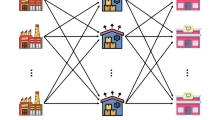Abstract
In this paper, we propose a dynamic and stochastic approach for an inventory routing problem in which products with a high perishability must be delivered from a supplier to a set of customers. This problem falls within the agri-food supply chain (\({\mathcal {ASC}}\)) management field, which includes all the activities from production to distribution. The need for high-quality products that are subject to perishability is a critical issue to consider in the \({\mathcal {ASC}}\) optimization. Moreover, the demand uncertainty makes the problem very challenging. In order to effectively manage all these features, a rolling horizon approach based on a multistage stochastic linear program is proposed. Computational experiments over medium-size instances designed on the basis of the real data provided by an agri-food company operating in Southern Italy show the effectiveness of the proposed approach.


Similar content being viewed by others
References
Adulyasak Y, Cordeau JF, Jans R (2015) The production routing problem: a review of formulations and solution algorithms. Comput Oper Res 55:141–152
Ahumada O, Villalobos J (2009) Application of planning models in the agri-food supply chain: a review. Eur J Oper Res 196(1):1–20
Al Shamsi A, Al Raisi A, Aftab M (2014) Pollution-inventory routing problem with perishable goods. Springer, Cham, pp 585–596
Amorim P, Günther HO, Almada-Lobo B (2012) Multi-objective integrated production and distribution planning of perishable products. Int J Prod Econ 138(1):89–101
Andersson F, Mausser H, Rosen D, Uryasev S (2001) Credit risk optimization with conditional value-at-risk criterion. Math Program 89(2):273–291
Aramyan L, Oude Lansink A, Van der Vorst J, Van Kooten O (2007) Performance measurement in agri-food supply chains: a case study. Supply Chain Manag Int J 12(4):304–315
Artzner P, Delbaen F, Eber JM, Heath D (1999) Coherent measures of risk. Math Finance 9(3):203–228
Banasik A, Kanellopoulos A, Bloemhof-Ruwaard J, Claassen G (2019) Accounting for uncertainty in eco-efficient agri-food supply chains: a case study for mushroom production planning. J Clean Prod 216:249–256
Beraldi P, De Simone F, Violi A (2010) Generating scenario trees: a parallel integrated simulation-optimization approach. J Comput Appl Math 233(9):2322–2331
Beraldi P, Violi A, Scordino N, Sorrentino N (2011) Short-term electricity procurement: a rolling horizon stochastic programming approach. Appl Math Model 35:3980–3990
Birge J, Louveaux F (1997) Introduction to stochastic programming. Springer, Berlin
Christopher M (2005) Logistics and supply chain management: creating value-added networks. Pearson education, London
Coelho L, Laporte G (2014) Optimal joint replenishment, delivery and inventory management policies for perishable products. Comput Oper Res 47:42–52
Diabat A, Abdallah T, Le T (2016) A hybrid tabu search based heuristic for the periodic distribution inventory problem with perishable goods. Ann Oper Res 242(2):373–398
Diaz-Madroñero M, Mula J, Jiménez M, Peidro D (2016) A rolling horizon approach for material requirement planning under fuzzy lead times. Int J Prod Res. https://doi.org/10.1080/00207543.2016.1223382
Dupačová J, Consigli G, Wallace S (2000) Scenarios for multistage stochastic programs. Ann Oper Res 100(1):25–53
Ekşioğlu SD, Mingzhou J (2006) Cross-facility production and transportation planning problem with perishable inventory. Springer, Berlin, pp 708–717
Esteso A, Alemany M, Ortiz A (2018) Conceptual framework for designing agri-food supply chains under uncertainty by mathematical programming models. Int J Prod Res 56(13):4418–4446
Federgruen A, Prastacos G, Zipkin P (1986) An allocation and distribution model for perishable products. Oper Res 34(1):75–82
Guillén G, Mele F, Bagajewicz M, Espuña A, Puigjaner L (2005) Multiobjective supply chain design under uncertainty. Chem Eng Sci 60(6):1535–1553
Haijema R (2013) A new class of stock-level dependent ordering policies for perishables with a short maximum shelf life. Int J Prod Econ 143(2):434–439
Heitsch H, Römisch W (2003) Scenario reduction algorithms in stochastic programming. Comput Optim Appl 24(2):187–206
Hiassat A, Diabat A, Rahwan I (2017) A genetic algorithm approach for location-inventory-routing problem with perishable products. J Manuf Syst 42:93–103
Hsu CI, Hung SF, Li HC (2007) Vehicle routing problem with time-windows for perishable food delivery. J Food Eng 80(2):465–475
Jia T, Li X, Wang N, Li R (2014) Integrated inventory routing problem with quality time windows and loading cost for deteriorating items under discrete time. Math Probl Eng 2014:1–14
Kaut M, Wallace S (2007) Evaluation of scenario-generation methods for stochastic programming. Pac J Optim 3(2):257–271
Le T, Diabat A, Richard JP, Yih Y (2013) A column generation-based heuristic algorithm for an inventory routing problem with perishable goods. Optim Lett 7(7):1481–1502
Nielsen L, Kroon L, Maróti G (2012) A rolling horizon approach for disruption management of railway rolling stock. Eur J Oper Res 220(2):496–509
Osvald A, Stirn L (2008) A vehicle routing algorithm for the distribution of fresh vegetables and similar perishable food. J Food Eng 85(2):285–295
Rockafellar R, Uryasev S (2000) Optimization of conditional value-at-risk. J Risk 2:21–41
Rong A, Akkerman R, Grunow M (2011) An optimization approach for managing fresh food quality throughout the supply chain. Int J Prod Econ 131(1):421–429
Salin V (1998) Information technology in agri-food supply chains. Int Food Agribus Manag Rev 1(3):329–334
Shaabani H, Kamalabadi I (2016) An efficient population-based simulated annealing algorithm for the multi-product multi-retailer perishable inventory routing problem. Comput Ind Eng 99:189–201
Soysal M, Bloemhof-Ruwaard J, Haijema R, Van der Vorst JG (2015) Modeling an inventory routing problem for perishable products with environmental considerations and demand uncertainty. Int J Prod Econ 164:118–133
Soysal M, Bloemhof-Ruwaard J, Haijema R, Van der Vorst JG (2018) Modeling a green inventory routing problem for perishable products with horizontal collaboration. Comput Oper Res 89:168–182
Van Elzakker M, Zondervan E, Raikar N, Hoogland H, Grossmann I (2014) Optimizing the tactical planning in the fast moving consumer goods industry considering shelf-life restrictions. Comput Chem Eng 66:98–109
Wallace S, Ziemba W (2005) Applications of stochastic programming, MPS-SIAM series in optimization, MPS, Philadelphia
Zamarripa M, Marchetti P, Grossman I, Singh T, Lotero I, Gopalakrishnan A, Besancon B, André J (2016) Rolling horizon approach for production-distribution coordination of industrial gases supply chains. Ind Eng Chem Res 55(9):2646–2660
Zenios S, Ziemba W (eds) (2008) Handbook of asset and liability management. North-Holland, San Diego
Zhu Z, Chu F, Dolgui A, Chu C, Zhou W, Piramuthu S (2018) Recent advances and opportunities in sustainable food supply chain: a model-oriented review. Int J Prod Res 56(17):5700–5722
Acknowledgements
This work has been partially supported by Italian Minister of University and Research with the grant for research project PON\(01\_00878\) “DIRECT FOOD”.
Author information
Authors and Affiliations
Corresponding author
Ethics declarations
Conflict of interest
The authors declare that they have no conflict of interest.
Additional information
Communicated by M. Squillante.
Publisher's Note
Springer Nature remains neutral with regard to jurisdictional claims in published maps and institutional affiliations.
Route generation procedure
Route generation procedure
This section illustrates the algorithm designed for generating the subset of feasible routes, for each instance and for each scenario tree. The procedure creates clusters of retailers by considering their aggregate demand for a relevant subset of scenarios, and generates one or more feasible routes for each cluster. For each scenario and for each time level, a subset of retailers is identified according to the following rule: a retailer is included in the subset if the service is necessary to avoid stock-out at that time, in the scenario. Then, for each subset of retailers a Capacitated Vehicle Routing Problem (\({\mathcal {CVRP}}\)) is solved. The quantity to deliver to each retailer in the subset is equal to the expected demand in the specific scenario and for the given time level. The routes obtained by the solution of the \({\mathcal {CVRP}}\) are evaluated to be included in the set of all the routes that are considered in the mathematical formulation presented in Sect. 3.1: only the routes that occur in almost a given number of solutions are added to the subset of all feasible routes. In the following, a brief description of the algorithm is proposed.
For a generic scenario s, let \(N_s\) be the set of nodes which belong to s. Let \(C_{s,n}\) be the cluster of retailers for node \(n \in N\), and let \(D_{s,n}\) be the overall demand of the retailers in s at level n. Moreover, let \(\alpha _{k}\) be the number of times route k occurs in any solution. Finally, let R be the set of routes that are generated. Initially \(R = \{ \overline{r}, r_1, \ldots , r_k, \ldots , r_{|K|} \}\), where \(\overline{r}\) is the giant tour and \(r_k, \ \forall k = 1, \ldots , |K|,\) is the direct delivery for retailer \(k \in K\). The overall procedure is outlined in Algorithm 1

More specifically, step 1 builds clusters for each scenario \(s \in S\) and for each node \(n \in N_s\) are constructed. The details of the clustering algorithm are reported in Algorithm 2

Step 2 performs a check of the vehicle capacity with aim to build clusters such that the total amount of product to deliver is less or equal to the total capacity of the fleet. Details are provided by Algorithm 3

Step 3 outlines how routes are constructed and selected. Algorithm 4 provides a whole overview of the routes generation procedure.

Rights and permissions
About this article
Cite this article
Violi, A., Laganá, D. & Paradiso, R. The inventory routing problem under uncertainty with perishable products: an application in the agri-food supply chain. Soft Comput 24, 13725–13740 (2020). https://doi.org/10.1007/s00500-019-04497-z
Published:
Issue Date:
DOI: https://doi.org/10.1007/s00500-019-04497-z




